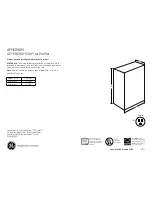
SS-SVX09A-EN
65
Installation
Discharge Air Sensor (Honeywell 6RT1)
A discharge air sensor ships with each unit when the constant volume control option is ordered.
The sensor should be installed in a turbulent free area of the discharge air duct at a location that
will provide accurate supply air sensing. Refer to the illustration in
Figure 33
for installation and
sensor dimensional information.
WARNING
Hazardous Voltage!
Disconnect all electric power, including remote disconnects before servicing. Follow proper
lockout/tagout procedures to ensure the power can not be inadvertently energized. Failure to
disconnect power before servicing could result in death or serious injury.
Wire the sensor in accordance with the field connection diagram in
Figure 32
. As shipped form the
factory, a resistor (7R1) is installed on terminal board 1TB8 terminals 5 & 6). Remove this resistor
when the sensor is installed. Shielded cable (Belden 8760 or equivalent) must be used when wiring
the sensor to the terminal board inside the unit’s control panel.
When the sensor is installed, it serves two functions;
1.
It sends the supply air temperature to the master energy controller (MEC), in the form of an
analog input, to assist in the rate at which the system changes the space temperature. By
offsetting the actual zone thermostat setpoint, up or down, the MEC can closer control the zone
comfort level.
2. It serves as a low limit for the system when the supply air temperature reaches too high a delta
tee between the actual supply air temperature and the zone temperature to help prevent
overshooting of the zone thermostat setpoint.
Table 11. (Q667) Switching Subbase
Subbase Switch Positions
Check Continuity between These
Terminal Pairs
Circuit should
be
Fan
System
ON
N/A
9 (Subbase) & 10 (Subbase)
Closed
AUTO
OFF
9 (Subbase) & 10 (Subbase)
Open
5 (Subbase) & 5 (T’stat)
Open
4 (Subbase) & 4(T’Stat)
Open
AUTO
HEAT
9 (Subbase) & 10 (Subbase)
Open
5 (Subbase) & 5 (T’stat)
Closed
4 (Subbase) & 4(T’Stat)
Open
AUTO
AUTO
9 (Subbase) & 10 (Subbase)
Closed
5 (Subbase) & 5 (T’stat)
Closed
4 (Subbase) & 4(T’Stat)
Closed
AUTO
COOL
9 (Subbase) & 10 (Subbase)
Closed
5 (Subbase) & 5 (T’stat)
Open
4 (Subbase) & 4(T’Stat)
Closed
Summary of Contents for RAUC-C20
Page 10: ...10 SS SVX09A EN Installation Figure 3 RAUC C20 Unit Dimensional Data Recommended Clearances...
Page 11: ...SS SVX09A EN 11 Installation Figure 4 RAUC C25 Unit Dimensional Data Recommended Clearances...
Page 12: ...12 SS SVX09A EN Installation Figure 5 RAUC C30 Unit Dimensional Data Recommended Clearances...
Page 13: ...SS SVX09A EN 13 Installation Figure 6 RAUC C40 Unit Dimensional Data Recommended Clearances...
Page 14: ...14 SS SVX09A EN Installation Figure 7 RAUC C50 Unit Dimensional Data Recommended Clearances...
Page 15: ...SS SVX09A EN 15 Installation Figure 8 RAUC C60 Unit Dimensional Data Recommended Clearances...
Page 55: ...SS SVX09A EN 55 Installation Field Connection Diagram Notes for all System Control Options...
Page 67: ...SS SVX09A EN 67 Installation Figure 33 6RT1 Discharge Air Sensor Assembly...
Page 96: ...96 SS SVX09A EN System Start Up Figure 47 20 Ton Pressure Curve...
Page 97: ...SS SVX09A EN 97 System Start Up Figure 48 25 Ton Pressure Curve...
Page 98: ...98 SS SVX09A EN System Start Up Figure 49 30Ton Pressure Curve...
Page 99: ...SS SVX09A EN 99 System Start Up Figure 50 40 Ton Pressure Curve per Circuit...
Page 100: ...100 SS SVX09A EN System Start Up Figure 51 50 Ton Pressure Curve per Circuit...
Page 101: ...SS SVX09A EN 101 System Start Up Figure 52 60 Ton Pressure Curve per Circuit...
















































